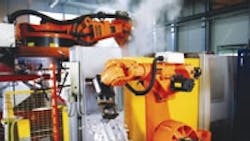"Avoid the mistake of buying a robot and just being content with the expectation that lean process results will automatically occur." That's only the first caution from John Burg, president of Ellison Technologies Automation. His caveats continue: "Improve the task or process before automating it -- and get your organization to agree to the cultural shift that a lean commitment requires. Only then will robot tending of a machine tool or process pay off."
Burg's advice accrues from serving as the robotic services provider for Ellison Technologies, a U.S. Mori Seiki machine tool distributor. His operating strategy: "Only with the conscious application of lean principles can the full potential of the robot application be attained."
He recommends a formal investigation to validate the presence of lean processes. "Go beyond merely accepting verbal claims from the engineering department. Despite their assurances on lean, we often discover that machine operators are compensating for a whole host of inefficiencies in the cell. Why? In many cases engineering management may simply not know. In those cases the discovery is made after the robot is installed in the machining cell." He says the key to success is to always ask the operator: "How does this thing [process] run?"
He says the operative explanation is something like, "Well, that's the way we've always done it." In most cases the engineering staffs in those organizations are typically stretched so thin that they don't have the time to look at things that are already functional, but perhaps not optimally.
Surprisingly, Burg identifies that type of practice -- or lack of practice -- as typical in U.S. operations. "I don't think that assessment is outside the norm," he charges. "And there tend to be thousands of reasons given while it is really a matter of time availability -- and discipline."
The other side of the coin is that a proper lean analysis may also show that there is no case for a robot implementation, adds Burg. "Correctly assessing the lean opportunity for robots is a significant consideration -- both for the customer and for us."
The greatest strategic advantage, Burg adds, is to use lean practices as a competitive tool to maintain U.S. manufacturing -- to save the facility from outsourcing.
See Also
